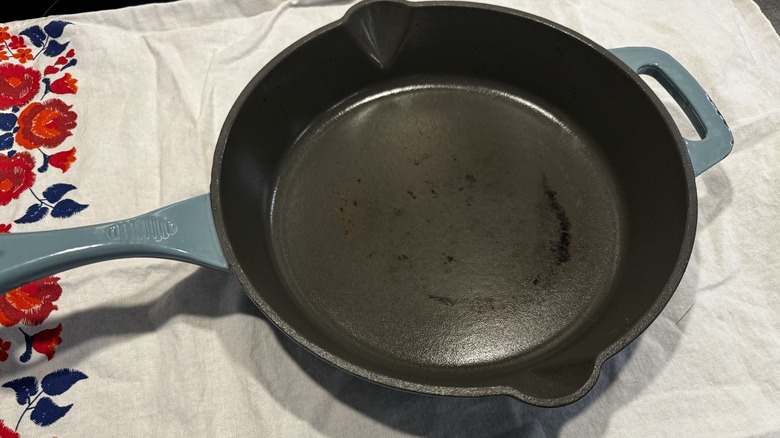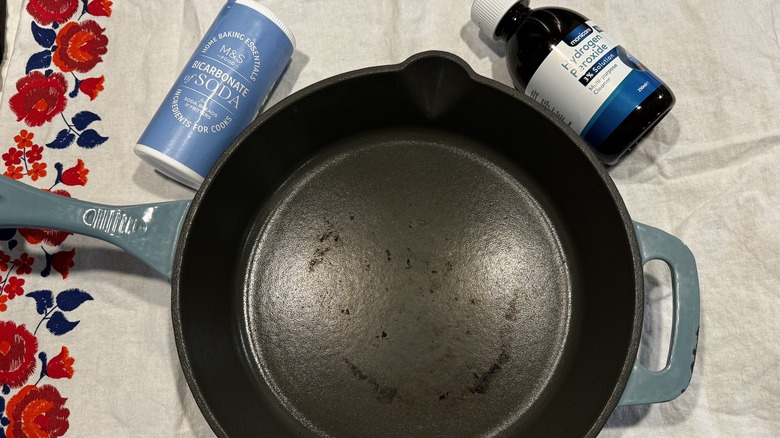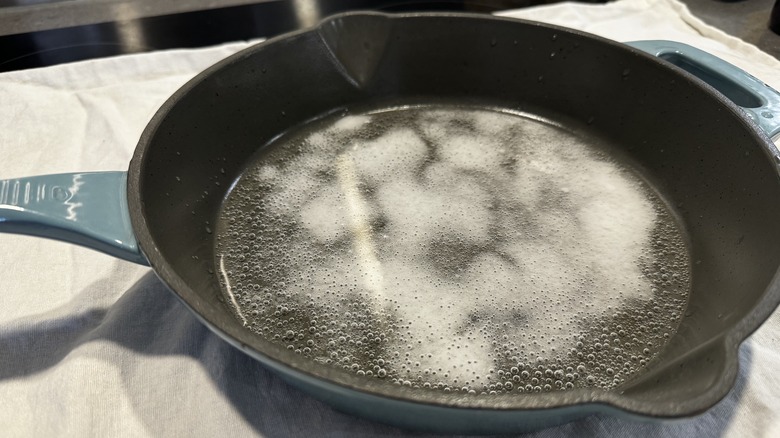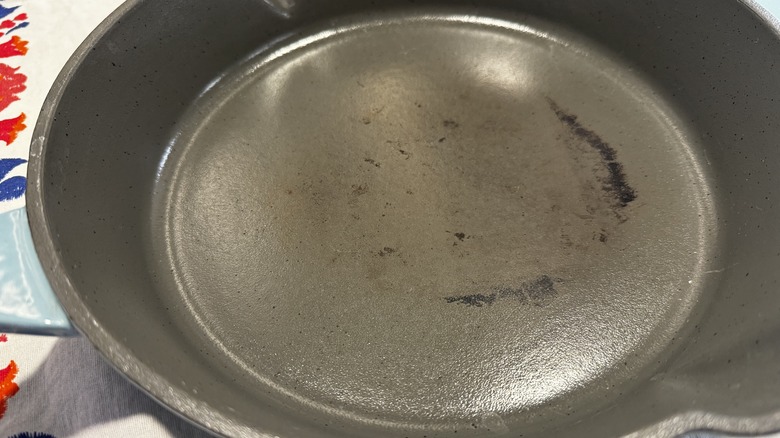Stained Cast Iron Vs. Hydrogen Peroxide & Baking Soda: Heavy Metal Win Or Rusty Disaster?
One day, I realized that my once-treasured enameled cast iron skillet was no longer my go-to pan. When I first bought it, I was thrilled to finally have a heavy-duty skillet that was lower maintenance and didn't require as much care as regular cast iron. But over time, the beautiful pan had become stained and spotted, and I started reaching for my good old-fashioned non-stick pan. I have tried many methods to revive my skillet, from regular dish soap and hot water with a hard-sided sponge, to Bar Keepers Friend and a non-stick safe scouring pad. The burnt-on food came off just fine, but I found that the stains were impossible to remove.
The trick with removing stains from enameled cast iron is that you don't want to use anything too caustic or abrasive, as this can deteriorate the enamel finish. The enamel finish is what makes this type of cast iron semi-non-stick. It also conducts heat easily and evenly, so you want to leave it intact. Finally, I came across a stain removal hack for enamel cast iron that I hadn't seen before, but that seemed perfect for my needs: baking soda and hydrogen peroxide. After some research, I decided to see if this was the right combination to finally revive my beloved enamel cast iron skillet.
Why hydrogen peroxide and baking soda work
The hydrogen peroxide and baking soda combination immediately stood out to me as a winning combination for a few reasons. For one, I spend a lot of my days researching and trying DIY cleaning solutions, so believe me when I say I have used all kinds of ingredients to clean with. I've even used Alka-Seltzer to mop my floors. With all of these trials, I come back to hydrogen peroxide over and over again and find it to be one of the most underrated ingredients in the DIY cleaner game.
Hydrogen peroxide is a versatile cleaner and particularly good at getting rid of discoloration — you probably already use it as a stain remover, even if you don't realize it! When combined with sodium carbonate (soda ash), hydrogen peroxide becomes sodium percarbonate. Also known as color-safe bleach, it is the key bleaching ingredient found in Oxiclean. On its own, hydrogen peroxide is still pretty powerful and is known to lift food and wine stains from fabrics. So it made sense to use it to clean up food stains in my trusty cast iron skillet.
Additionally, baking soda is one of the most multi-functional cleaning ingredients around. It's gently abrasive and lightly alkaline, enabling it to chemically break down acidic compounds, all while physically removing debris that may be causing staining.
How to clean stained pans with hydrogen peroxide
I found a few suggestions for how to clean enameled cast iron cookware with hydrogen peroxide and baking soda, but ultimately decided on what I found to be the simplest and most straightforward option. I simply wiped the pan down to ensure there weren't any food particles or dust stuck to it, then added a layer of hydrogen peroxide to the pan, enough to cover it completely, then sprinkled some baking soda on top. After about thirty minutes, I checked on the experiment and saw hundreds of tiny bubbles had formed in the pan — surely a good sign, I thought. I left the mixture to sit for an hour, then came back and washed it with soap and warm water.
Other methods called for heating the hydrogen peroxide-baking soda mixture in the pan, bringing it to a boil, then turning the heat off and cleaning the pan as usual. I decided against this primarily because I didn't want to have to wait for the pan to cool before starting to scrub, but also because after some research, I learned that heating hydrogen peroxide to a boil isn't the wisest move. At best, it causes the hydrogen peroxide (which is typically already diluted in water in most household-safe formulations), to dissipate into water and oxygen, and at worst, can become combustible at high temperatures. All in all, I recommend skipping this option.
Does hydrogen peroxide remove enamel cast iron stains?
When the time was up, I rinsed the solution away and scrubbed for a few minutes with much vigor, using a gentle scouring pad. Sadly, even after several minutes of scrubbing, and even adding extra baking soda onto the pan to form an abrasive paste, none of the discoloration lifted. My pan was still just as stained as it had been before. In the end, hydrogen peroxide and baking soda weren't enough to clean up my enameled cast iron.
I did notice that the before and after photos I took seem to make the burn marks look worse in the before photos, but I chalk this up to nothing more than a subtle lighting change. In person, I don't think the pan looked any different. So, while hydrogen peroxide and baking soda won't remove stains from your enameled cast iron, the combination didn't seem to do anything to harm it. My pan is the same as it was before.



